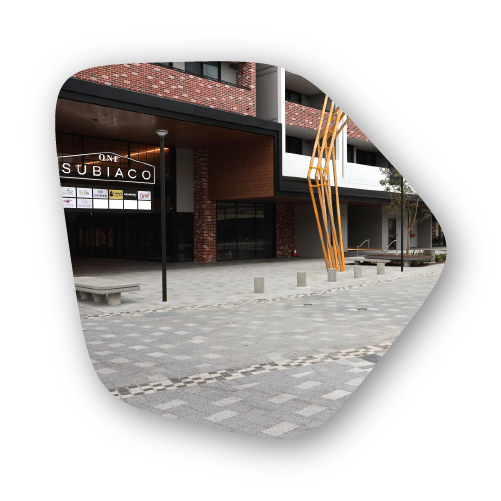
Here are 10 of the most popular Natural Stones and Finishes!
Whether you are laying paving stones as a new surface or perhaps refining and giving a glow-up to an older ‘classic’ surface, natural stone has many unique characteristics which it holds. They are available in a variety of finishes and many different types of surfaces. There are also a lot of new finishes which are regularly being added to the selection.The range of finishes of stone are achieved by using different mechanical processes and other techniques that allow the stone to be adapted for specific uses, especially as stone pavers.
It’s important to choose a type of finish of your stone pavers that will suit your intended use for the stone. This article aims to highlight the most frequently requested and used stone finishes, and which stones that the finishes are best applied to and the ideal place of where to lay them.
1- NATURAL SPLIT:
The finish called natural split, as the name suggests, is truly natural stone that looks like it has just been split. The stone is not treated in any way, after it is extracted from the quarry. Then it is simply cut into blocks and sold to the market and wholesalers as is. The stone’s final appearance will depend on its natural look. Because it is natural and no two stones will look the same, it will always differ slightly. However if you install the natural split finish stone pavers outside, they will require sealing to protect them from the elements like head and rain. Popular stones which are available at most stone stores with a natural finish are Porphyry, Himalayan Sandstone and Quartz .
2- TUMBLED:
The stones which are most suited- and also popular to utilise a tumbled finish, include travertine, limestone and marble. The tumbled finish will give the natural stone pavers immense character and a warmth to them.The tumbled finish is basically an part of an ageing effect, and is best suited for highly resistant natural stones. The tumbled look creates softer surfaces and rumbled edges, this is why it is quite a popular finish. It’s a beautiful and aesthetically pleasing choice as external pavers.
3- POLISHED:
Polished finishes are a perfect choice for indoor uses like walls and bench-tops. However, polished finish can be quite slippery, so it’s not suited for outdoor paving. The natural stone will undergo repeated treatment with abrasives until the surface is a glossy, mirror-like surface to achieve a polished finish. This will bring out the stone’s natural colours. The character of the stone is brought to life through this process, and means you can’t really see any porous features anymore. The great thing about a polished finish is that it can really boost the overall resistance of the stone.
4- MICRO-SANDED:
This finish is generally used on outdoor Porcelain Tiles and Pavers, and recreates the look and feel of natural sandstone. Micro-sanding technology will create a sandpaper type of finish to
give these pavers slip-resistant qualities. Because of this, these pavers can be an ideal choice for pools, wet areas and pathways which are exposed to the elements.
5- BUSH HAMMERED:
This process produces textured surfaces that have small evenly spaced pits either produced by hand or pneumatic hammer. This finish is typically applied to granite. Using specialised tools, this gives the stone more texture and makes the surface more resistant to slips.
6- SANDBLASTED:
This finish is a matte-textured surface, produced by small particles (“sand”) which strike the stone surface at very high speeds. This finish is achieved by blasting the stone several times with this air gun which contains the abrasive agent. This can even lighten its colour, as well as give the textured surface.
An advantage of sandblasting is it can increase the slip-resistance to the stone. Which makes it a fabulous finish for stone paving outside. Stone which respond particularly well to a sandblasted finish are sandstone, limestone, marble, and bluestone.
7- FLAMED OR THERMAL:
A flamed finish will tend to have the benefit of anti-slip and have more grip, so it makes them a perfect choice for outdoor paving. As suggested, a flamed or thermal finish is when the stone is exposed to high temperatures (typically in the form of a flame). This process will alter the colour of the stone and can give a characteristic roughness to the stone.
8- SAWED OR SAWN:
The sawed finish is quite popular with bluestone pavers and sandstone pavers. A sawed (or sawn) finish is of the appearance where the stone has been cut by a blade with some of the saw marks being visible. This effect results in a textured and irregular surface that has a rough feel. Sawed finish can make stones slip-resistant, so it is another stone that is a popular choice for outdoor applications.
9- ACID-WASHED:
An acid-wash finish is when corrosive chemicals are applied to the stone’s surface. Most natural stones will be able to withstand an acid-washed finish. These chemicals burn through the stone which creates small pitted indentations on the surface. This naturally rustic look and feel also has the advantage that any scratches which occur from wear and tear over time on the stone are much less visible.
10- HONED:
Honed finishes are smooth and non-reflective, that give a satiny sheen. They can be used for both interior and exterior stone surfaces. A honed finish is achieved when rubber heads are used to smooth out the stone’s surface which creates an overall consistency and uniformity in the stone’s texture. When manufacturers are finalising the honed finish, they almost sand the stone to just before it reaches the polished phase. This is why it has a lack of glossiness, as it is more of a matte appearance.
As you can see there are so many ways to change the look of natural stone. Over the years at Bonita Stone, we have found the most popular and the safest options for pavers to help narrow down your choice, and will be able to advise you which surface finish will work best for your project. For further information about our stone finishes and stone pavers, please contact the team of friendly experts who will be able to go through your questions and help bring your next project to life.






